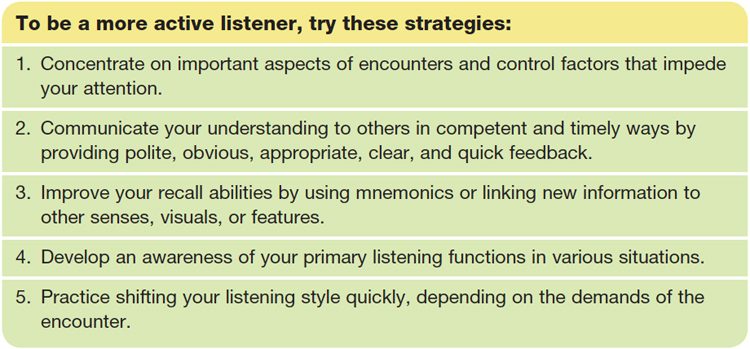5.3.1 Four Listening Styles
Printed Page 160
Four Listening Styles
Your listening style is your habitual pattern of listening behaviors, which reflects your attitudes, beliefs, and predispositions regarding the listening process (Watson, Barker, & Weaver, 1995). Four different primary listening styles exist (Bodie & Worthington, 2010). Action-oriented listeners want brief, to-the-point, and accurate messages from others—information they can then use to make decisions or initiate courses of action. Action-oriented listeners can grow impatient when communicating with people they perceive as disorganized, long-winded, or imprecise in their talk. For example, when faced with an upset spouse, an action-oriented listener would want information about what caused the problem, so a solution could be generated. He or she would be less interested in hearing elaborate details of the spouse’s feelings.
Action-Oriented Listeners
Watch this clip online to answer the questions below.

Question
Want to see more? Check out the Related Content section for additional clips on time-oriented listeners and content-oriented listeners.
Time-oriented listeners prefer brief and concise encounters. They tend to let others know in advance exactly how much time they have available for each conversation. Time-oriented listeners want to stick to their allotted schedules, and often look at clocks, watches, or phones to ensure this is the case (Bodie & Worthington, 2010).
In contrast, people-oriented listeners view listening as an opportunity to establish commonalities between themselves and others. When asked to identify the most important part of effective listening, people-oriented listeners cite concern for other people’s emotions. Like Fred Rogers, they strive to demonstrate empathy when listening by using positive feedback and offering supportive responses. People-oriented listeners tend to score high on measures of extraversion and overall communication competence (Villaume & Bodie, 2007).

Content-oriented listeners prefer to be intellectually challenged by the messages they receive during interpersonal encounters. They enjoy receiving complex and provocative information. Content-oriented listeners often take time to carefully evaluate facts and details before forming an opinion about information they’ve heard. Of the four listening styles, content-oriented listeners are the most likely to ask speakers clarifying or challenging questions (Bodie & Worthington, 2010).
Most of us use only one or two listening styles in all of our interpersonal interactions (Chesebro, 1999). One study found that 36.1 percent of people reported exclusively using a single listening style across all of their interpersonal encounters; an additional 24.8 percent reported that they never use more than two different styles (Watson et al., 1995). We also resist attempts to switch from our dominant styles, even when those styles are ill-suited to the situation at hand. This can cause others to perceive us as insensitive, inflexible, and even incompetent communicators.

To be an active listener, you have to use all four styles, so you can strategically deploy each of them as needed. For example, in situations where your primary listening function is to provide emotional support—when friends, family members, or romantic partners obviously want to discuss feelings or turn to you for comfort—you should quickly adopt a people-oriented listening style (Barker & Watson, 2000). Studies document that use of a people-oriented listening style substantially boosts others’ perceptions of your interpersonal sensitivity (Chesebro, 1999). In such encounters, use of a content-, time-, or action-oriented style would likely be perceived as incompetent.
By contrast, if your dominant listening function is to comprehend—for instance, during a training session at work—you’ll need to use a content-oriented listening style. Similarly, if you’re talking with someone who is running late for an appointment or who has to make a decision quickly, you should use a more time- or action-oriented style. For additional tips on how to improve your active listening, see Table 5.1.
Table 5.1 Active Listening
